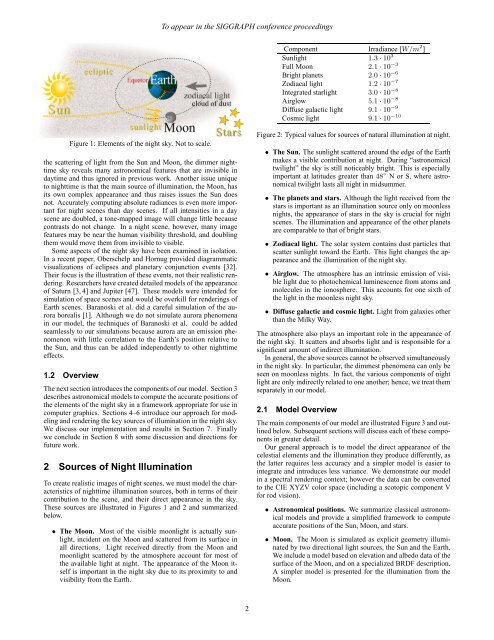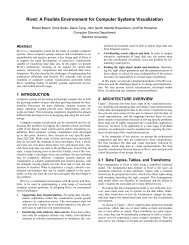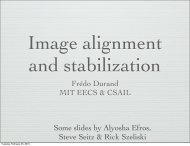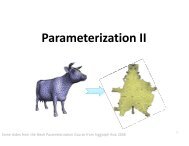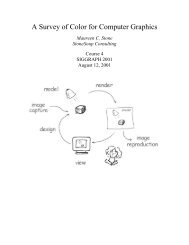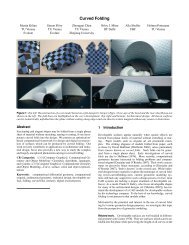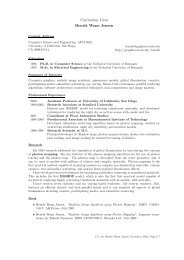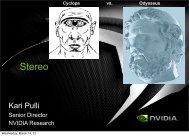A Physically-Based Night Sky Model - Computer Graphics Laboratory
A Physically-Based Night Sky Model - Computer Graphics Laboratory
A Physically-Based Night Sky Model - Computer Graphics Laboratory
You also want an ePaper? Increase the reach of your titles
YUMPU automatically turns print PDFs into web optimized ePapers that Google loves.
Figure 1: Elements of the night sky. Not to scale.<br />
the scattering of light from the Sun and Moon, the dimmer nighttime<br />
sky reveals many astronomical features that are invisible in<br />
daytime and thus ignored in previous work. Another issue unique<br />
to nighttime is that the main source of illumination, the Moon, has<br />
its own complex appearance and thus raises issues the Sun does<br />
not. Accurately computing absolute radiances is even more important<br />
for night scenes than day scenes. If all intensities in a day<br />
scene are doubled, a tone-mapped image will change little because<br />
contrasts do not change. In a night scene, however, many image<br />
features may be near the human visibility threshold, and doubling<br />
them would move them from invisible to visible.<br />
Some aspects of the night sky have been examined in isolation.<br />
In a recent paper, Oberschelp and Hornug provided diagrammatic<br />
visualizations of eclipses and planetary conjunction events [32].<br />
Their focus is the illustration of these events, not their realistic rendering.<br />
Researchers have created detailed models of the appearance<br />
of Saturn [3, 4] and Jupiter [47]. These models were intended for<br />
simulation of space scenes and would be overkill for renderings of<br />
Earth scenes. Baranoski et al. did a careful simulation of the aurora<br />
borealis [1]. Although we do not simulate aurora phenomena<br />
in our model, the techniques of Baranoski et al. could be added<br />
seamlessly to our simulations because aurora are an emission phenomenon<br />
with little correlation to the Earth’s position relative to<br />
the Sun, and thus can be added independently to other nighttime<br />
effects.<br />
1.2 Overview<br />
The next section introduces the components of our model. Section 3<br />
describes astronomical models to compute the accurate positions of<br />
the elements of the night sky in a framework appropriate for use in<br />
computer graphics. Sections 4–6 introduce our approach for modeling<br />
and rendering the key sources of illumination in the night sky.<br />
We discuss our implementation and results in Section 7. Finally<br />
we conclude in Section 8 with some discussion and directions for<br />
future work.<br />
2 Sources of <strong>Night</strong> Illumination<br />
To create realistic images of night scenes, we must model the characteristics<br />
of nighttime illumination sources, both in terms of their<br />
contribution to the scene, and their direct appearance in the sky.<br />
These sources are illustrated in Figures 1 and 2 and summarized<br />
below.<br />
• The Moon. Most of the visible moonlight is actually sunlight,<br />
incident on the Moon and scattered from its surface in<br />
all directions. Light received directly from the Moon and<br />
moonlight scattered by the atmosphere account for most of<br />
the available light at night. The appearance of the Moon itself<br />
is important in the night sky due to its proximity to and<br />
visibility from the Earth.<br />
To appear in the SIGGRAPH conference proceedings<br />
2<br />
Component Irradiance [W/m 2 ]<br />
Sunlight 1.3 · 10 3<br />
Full Moon 2.1 · 10 −3<br />
Bright planets 2.0 · 10 −6<br />
Zodiacal light 1.2 · 10 −7<br />
Integrated starlight 3.0 · 10 −8<br />
Airglow 5.1 · 10 −8<br />
Diffuse galactic light 9.1 · 10 −9<br />
Cosmic light 9.1 · 10 −10<br />
Figure 2: Typical values for sources of natural illumination at night.<br />
• The Sun. The sunlight scattered around the edge of the Earth<br />
makes a visible contribution at night. During “astronomical<br />
twilight” the sky is still noticeably bright. This is especially<br />
important at latitudes greater than 48 ◦ N or S, where astronomical<br />
twilight lasts all night in midsummer.<br />
• The planets and stars. Although the light received from the<br />
stars is important as an illumination source only on moonless<br />
nights, the appearance of stars in the sky is crucial for night<br />
scenes. The illumination and appearance of the other planets<br />
are comparable to that of bright stars.<br />
• Zodiacal light. The solar system contains dust particles that<br />
scatter sunlight toward the Earth. This light changes the appearance<br />
and the illumination of the night sky.<br />
• Airglow. The atmosphere has an intrinsic emission of visible<br />
light due to photochemical luminescence from atoms and<br />
molecules in the ionosphere. This accounts for one sixth of<br />
the light in the moonless night sky.<br />
• Diffuse galactic and cosmic light. Light from galaxies other<br />
than the Milky Way.<br />
The atmosphere also plays an important role in the appearance of<br />
the night sky. It scatters and absorbs light and is responsible for a<br />
significant amount of indirect illumination.<br />
In general, the above sources cannot be observed simultaneously<br />
in the night sky. In particular, the dimmest phenomena can only be<br />
seen on moonless nights. In fact, the various components of night<br />
light are only indirectly related to one another; hence, we treat them<br />
separately in our model.<br />
2.1 <strong>Model</strong> Overview<br />
The main components of our model are illustrated Figure 3 and outlined<br />
below. Subsequent sections will discuss each of these components<br />
in greater detail.<br />
Our general approach is to model the direct appearance of the<br />
celestial elements and the illumination they produce differently, as<br />
the latter requires less accuracy and a simpler model is easier to<br />
integrate and introduces less variance. We demonstrate our model<br />
in a spectral rendering context; however the data can be converted<br />
to the CIE XYZV color space (including a scotopic component V<br />
for rod vision).<br />
• Astronomical positions. We summarize classical astronomical<br />
models and provide a simplified framework to compute<br />
accurate positions of the Sun, Moon, and stars.<br />
• Moon. The Moon is simulated as explicit geometry illuminated<br />
by two directional light sources, the Sun and the Earth.<br />
We include a model based on elevation and albedo data of the<br />
surface of the Moon, and on a specialized BRDF description.<br />
A simpler model is presented for the illumination from the<br />
Moon.


